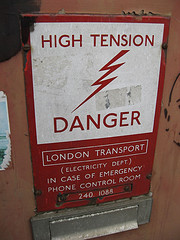In recent days, Congressional opponents of the Iran agreement were unable to stop it from going into effect. This is a big win for the Obama administration, which—after two years of negotiations with European allies, China, Russia and Iran—worked hard for months to convince Senators to support the historic agreement.

Photo: Flickr user R/DV/RS under CC 2.0
The administration consistently maintained that the United States is better off with an agreement than without one. Without an agreement, Iran would remain free to continue to expand uranium enrichment and related capabilities with only limited oversight. With the agreement, Iran’s capabilities will be strictly limited for a decade or more, and inspections will be much more direct and permanent, providing greater transparency about Iranian actions.
This is not to say that Iran and the United States are new BFFs. Far from it. As President Obama noted in his speech announcing the agreement, “you don’t make deals like this with your friends.”
Now that the Iran agreement is done, it would behoove U.S. officials to keep that sentiment in mind when it comes to Russia. Hiding behind the Iran headlines, recent reports indicate that U.S. military leaders now—for the first time in decades—see Russia as the biggest threat that the United States faces. This raises new questions about the U.S.-Russia relationship and the future of arms control agreements between the two.
Tensions with Russia
The change is not completely unjustified. Russia’s military activities in Ukraine, its dramatic increase in border-testing bomber flights, and ominous and ill-advised rhetoric on nuclear weapons have clearly changed the international security dynamic. And some of the responses from NATO and the United States, in particular nuclear saber rattling, have done little to calm things down. This led some to suggest that now is a particularly bad time to be talking about arms control. Others have even gone so far as to suggest that the United States should pull out of existing treaties unless Russia starts behaving better.
But, as in the case of Iran, this would be a big mistake. Arms control agreements provide both information and stability. It is not in the interest of the United States, for example, to give up the on-site inspections and large-scale data exchanges on nuclear forces that accompany the New START (Strategic Arms Reduction Treaty) arms control agreement.
As Obama went on to note in his speech on the Iran deal, “We negotiated arms control agreements with the Soviet Union when that nation was committed to our destruction. And those agreements ultimately made us safer.” Ambassador Linton Brooks, who as the chief negotiator for the original START knows this territory well, recently reminded us that “arms control doesn’t require good relations. In fact, arms control among states with good relations is really sort of irrelevant.” And if that’s not clear enough, three retired military officials, in an op-ed responding to those who advocate pulling out of the Intermediate Nuclear Forces (INF) treaty because of Russian violations, further emphasize the real link between growing tensions and the importance of arms control agreements, “Because of growing U.S.-Russian tensions, bilateral arms-control agreements such as the INF and New START treaties are more important than ever.”
Arms control, in fact, became most effective in the post-World War II era, during a time of great mutual suspicion and competition between the United States and Soviet Union. With communication between the two countries minimal and provocations frequent, opportunities for disaster increased. The development of massive nuclear arsenals on both sides drastically raised the stakes. As tensions and close calls mounted—the Cuban Missile Crisis is a prime example, but there were plenty of others—each country recognized that it was better off accepting some limits on its own activities and arsenals in exchange for receiving assurances that its adversary was likewise constrained. Limitations on forces helped to control the spiraling arms race between the two, which was not only dangerous but also very costly.
During the Cold War, both U.S. and Russian leaders learned the lesson that agreed-upon communications and limitations served their needs better than unfettered competition. The two countries and their leaders lived through some of the most nerve-wracking close calls in history. Their hard-won realization that high tensions between their countries were increasing the risks on both sides to unacceptable levels prompted the negotiation of several key agreements and treaties.
A New New START?
The most recent addition to the history of U.S.-Russian arms control is the New START agreement, which was concluded in 2009 and entered into force in 2010. This agreement requires the United States and Russia to reduce their deployed strategic nuclear warheads to 1,550 each, and deployed strategic delivery vehicles to 700, with another 100 strategic delivery vehicles in reserve. Because of the way warheads are counted under the agreement (bombers are counted as carrying only one warhead, regardless of the number they actually hold), the real totals will be somewhat higher, about 1,800 deployed strategic warheads each. These reductions are to be completed by 2018, and the United States will not reach that level much earlier than the deadline. According to the latest data exchange, Russia is currently below the limit for deployed delivery vehicles, but still has reductions to make in the other two categories.
Despite the fact that neither the United States nor Russia has reached the limits under New START, it is already time to begin thinking about what comes next. The agreement expires in 2021, just three years after the parties are required to complete reductions, and it is unclear what, if anything, will replace it.
In a 2013 speech in Berlin, President Obama announced that, based on a Pentagon review, he had determined that the United States could reduce its deployed strategic nuclear weapons by an additional roughly one third, to no more than 1,000, without endangering U.S. security. Obama also stated his intention to seek negotiations with Russia to move toward this goal bilaterally. The Russian response, however, has been less than enthusiastic. In fact, it has been downright negative.
Now that the end of New START approaches, however, the need to prepare for what comes next is becoming more urgent. One option, written into the treaty, is to extend it for no more than five years. This is much less ambitious than a new agreement on deeper cuts, but would be better than nothing. After all, while there may be little chance of significant bilateral arms control progress in the immediate future, letting the agreement expire without a follow-on would end the transparency and predictability provided by the treaty’s monitoring and verification arrangements. It could risk de-stabilizing the U.S.-Russia relationship and potentially undermine the considerable progress that has been made to date in arms control and reductions. This is in no one’s interest. And despite tensions over Russian actions in Ukraine, both sides have generally stated continued support for New START and for ensuring stability in the strategic relationship.
Ambassador Brooks, who is also a former head of the National Nuclear Security Administration responsible for maintaining the U.S. nuclear stockpile, recently noted that “the Russian Federation, and—for the last half of the Cold War—the Soviet Union, did not like the idea that there was no regulation of the nuclear balance between the two countries.” He, like others, believes that Russia will ultimately want to avoid returning to this situation. That is in the U.S. interest too.
While the current situation in Ukraine is a gross violation of international law and Russia’s rhetoric on nuclear weapons is decidedly unhelpful – not to mention irresponsible—these are still not reasons to abandon arrangements that benefit both sides. Such agreements are more, not less, crucial in times of high tension, when communications are already strained, and misunderstandings may escalate more quickly than under calmer circumstances.
The importance of arms control, particularly at times of high tension, was one of the key lessons of the Cold War. We can only hope that it does not take personal experience of a near-disaster for current leaders to re-learn it.
